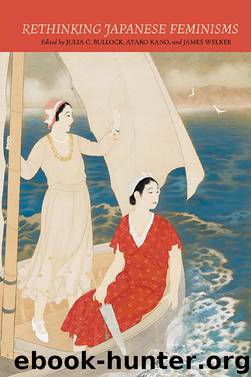Rethinking Japanese Feminisms by Bullock Julia C.; Kano Ayako; Welker James

Author:Bullock, Julia C.; Kano, Ayako; Welker, James
Language: eng
Format: epub
Publisher: University of Hawaii Press
Published: 2017-11-18T16:00:00+00:00
CHAPTER 9
Feminist Acts of Reading
Ariyoshi Sawako, Sono Ayako, and the Lived Experience of Women in Japan
BARBARA HARTLEY
In recent decades, revisionist feminist scholarship—scholarship that revisits previous research with a view to identifying how women have been elided—has retrieved the voices of many Japanese girls and women subjugated by conventional academic activity. The narratives of komori, child carers who were mere children themselves,1 and jokō, the young women whose arduous labor funded prewar Japanese state excesses, are two groups whose previously unknown stories owe their circulation to recent feminist activity. Similar work profiling individual women has ensured, for example, that the role of Kanno Suga (1881–1911), the radical activist journalist murdered by the Japanese state, is no longer concealed in the shadow of the Kōtoku Shūsui (1871–1911) legend.2
Some women’s narratives, nevertheless, remain outside the sphere of feminist endeavor, seemingly superfluous to a transnational movement, which, in the words of Chandra Talpade Mohanty, aims to highlight “a common context of struggles against exploitative structures and systems.”3 This essay will discuss two post–World War II women writers, Ariyoshi Sawako (1931–1984) and Sono Ayako (b. 1931), whose textual contributions have been largely overlooked in revisionist feminist inquiry. Sono, particularly, presents the conundrum of whether or not feminist researchers should concern themselves with the activities of women—often privileged—who hold political views that are violently contrary to their own. Although politically inoffensive in this sense, Ariyoshi has failed to capture the imagination of feminist scholars in the way that other literary women of her generation have.
In this discussion, I will argue for a feminist re-reading of the work of Ariyoshi and also of selected early texts by Sono. Since these narratives predate the transnational political consciousness that has informed Japanese feminist critiques of Japanese Imperial Army sex slavery policies, they may appear dated. Yet, Komashaku Kimi offers a feminist model for viewing such narratives as a way of “witnessing” women’s subordination to patriarchal authority. In her 1984 discussion that demonstrates the demeaning inference in the term “office flower” (shokuba no hana), widely used in reference to women office workers,4 Komashaku argues that postwar Japanese society forcibly categorized women as either prostitutes or wives. Each category derived from the same “source,” namely misogynist social attitudes.5 Observing how women were stripped of their humanity and thus objectified by the male gaze,6 Komashaku noted that the literary narrative had the capacity to act as “witness” to the lived experience of this objectification.7 This “witnessing” of women’s marginalized social position occurs in many texts by Ariyoshi and in selected texts, particularly early texts, by the now reviled Sono.
In her 1994 discussion of high-speed economic growth and the postwar family, Ueno Chizuko noted what was basically the self-infantalizing quality of the postwar Japanese male,8 who, she argued, regarded the husband/wife relationship as one of a mother and her son. If we overlay Ueno’s ideas with those of Komashaku, we can only conclude that Japanese women at the time of high-speed economic growth were rendered as objects—either prostitutes or wives—by a powerful collection of self-infantalizing males.
Download
This site does not store any files on its server. We only index and link to content provided by other sites. Please contact the content providers to delete copyright contents if any and email us, we'll remove relevant links or contents immediately.
| Africa | Americas |
| Arctic & Antarctica | Asia |
| Australia & Oceania | Europe |
| Middle East | Russia |
| United States | World |
| Ancient Civilizations | Military |
| Historical Study & Educational Resources |
The Sympathizer by Viet Thanh Nguyen(4104)
The Rape of Nanking by Iris Chang(4032)
World without end by Ken Follett(3352)
Ants Among Elephants by Sujatha Gidla(3284)
Blood and Sand by Alex Von Tunzelmann(3072)
Japanese Design by Patricia J. Graham(3012)
City of Djinns: a year in Delhi by William Dalrymple(2441)
Foreign Devils on the Silk Road: The Search for the Lost Treasures of Central Asia by Peter Hopkirk(2393)
Inglorious Empire by Shashi Tharoor(2349)
The Queen of Nothing by Holly Black(2342)
India's Ancient Past by R.S. Sharma(2315)
In Order to Live: A North Korean Girl's Journey to Freedom by Yeonmi Park(2306)
Tokyo by Rob Goss(2299)
India's biggest cover-up by Dhar Anuj(2256)
Tokyo Geek's Guide: Manga, Anime, Gaming, Cosplay, Toys, Idols & More - The Ultimate Guide to Japan's Otaku Culture by Simone Gianni(2248)
The Great Game: On Secret Service in High Asia by Peter Hopkirk(2237)
Goodbye Madame Butterfly(2168)
Batik by Rudolf Smend(2015)
Living Silence in Burma by Christina Fink(1993)
